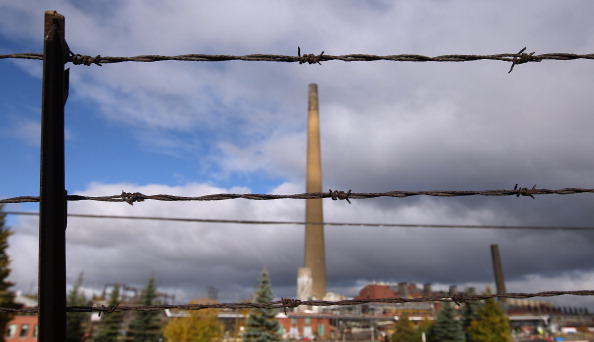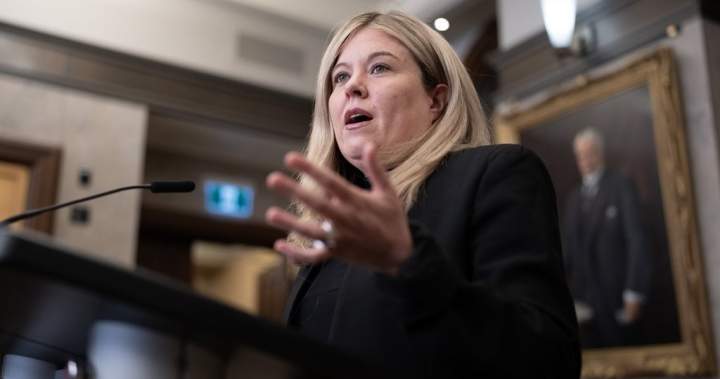Uncategorized
Ontario city skyline to undergo drastic change after ‘iconic’ landmark toppled

For years, residents and visitors to Sudbury, Ont., knew they were approaching the Nickel City when they saw the Inco Superstack.
“For us, it’s a beacon in our community,” Sudbury Mayor Paul Lefebvre told Global News. “You see Superstacks, you’re near home, right? You’re almost there because you can see it from pretty far away.”
But the skyline of Sudbury is undergoing a drastic change as plans are underway by current owner Vale Base Metals (VBM) to tear down the structure, as well as its neighbouring copper sister.
The company has made the Superstack and its little copper sister obsolete by finding more environmentally friendly way of dealing with emissions.
Before the arrival of the chimney, which residents refer to as “the Smokestack,” Sudbury was known as an environmental disaster, as spewing toxins made vegetation and wildlife in the area disappear.
“Vegetation could not survive,” Lefebvre said. “And certainly in the Copper Cliff area (where the mine is located) was really bad.”
Then came the Superstack in 1972.
Standing more than 1,250 Ft. high, it was, for a short time, the largest freestanding structure in the Western Hemisphere until it was surpassed by the CN Tower. Until it disappears, it will remain the largest chimney in Canada.
“If you look at the history of why it was built, it was just to get the sulphur to go further instead of having it landing right beside the community,” Lefebvre said.

Get breaking National news
For news impacting Canada and around the world, sign up for breaking news alerts delivered directly to you when they happen.
He noted that while that was a major innovation for its time, things have continued to evolve. In 2010, VBM, which acquired Inco in 2006, first announced the Clean AER Project, which would see the towering chimneys replaced with environmentally friendly and efficient methods of dealing with nickel extraction.
“The Superstack and Copperstack have been iconic landmarks in Greater Sudbury for decades,” said Gord Gilpin, director of Ontario operations for VBM.
“While we appreciate that the city’s landscape will look different after these structures are dismantled, our business has evolved and improved over time and this project is part of that evolution. We are modernizing our facilities and reducing our environmental footprint and, in so doing, laying the groundwork to ensure that our next century of mining in Sudbury is as successful as our first 100 years.”
The company says the move will eliminate 100,000 metric tonnes of sulphur dioxide emissions each year (equivalent to 1,000 railway tanker cars of sulphuric acid). It will also see the end of the Superstack and its copper counterpart, as they were decommissioned in 2020, and have been dormant ever since.
The company is just about finished with the demolition of the smaller Copperstack and is expected to turn its attention to the Superstack this summer.
“It’s a massive undertaking of how they’re going to do this,” Lefebvre said. “They had to prep for it the last five years and here we are, we’re on the cusp of it.”
The company says it will take about five years to pull down the towers and while some have argued that the towers should remain as a tribute to the city’s mining history and effort to clean up, the mayor said that is not a realistic option.
“There are some folks in the community that think we should keep it, but again, it’s not ours, right?” he said. “It’s the company’s and it’s a liability, because if they just leave it there, the whole thing will rust and the inside will, then it becomes a liability.”
Lefebvre also noted that the structure sits atop an active nickel mine, so there is no way it could ever be an attraction for people to visit and would be something that would need to be admired from afar.
While he is sad to see it go, the mayor noted that it is a weird twist that a place that once held such a bleak landscape would hold such an important stake in the world’s environment.
“The irony of all this is now Sudbury, that was one of the most polluted places back in the ’30s, ’40s, ’50s and ’60s, is now obviously contributing enormously with our critical minerals to our environment,” he said. “All electric vehicles and all battery, it needs nickel and we are the ones providing that across our entirety in the world.”
© 2025 Global News, a division of Corus Entertainment Inc.
Uncategorized
Springer cleared to return, will rehab with Bisons

TORONTO – Blue Jays slugger George Springer has been cleared to return to game action after suffering a concussion over two weeks ago, Toronto manager John Schneider said Wednesday.
The 35-year-old outfielder/designated hitter hasn’t played since July 28 when he was hit in the helmet by a fastball thrown by Baltimore Orioles pitcher Kade Strowd.
Springer, who was on hand for batting practice before Toronto’s game against the Chicago Cubs on Wednesday night, was expected to play for the Triple-A Buffalo Bisons on Thursday.
Related Videos
“Play DH tomorrow and then see if he needs a game in the outfield to see how he feels,” Schneider said in his pre-game availability. “But he’ll be doing that tomorrow.”

Get breaking National news
For news impacting Canada and around the world, sign up for breaking news alerts delivered directly to you when they happen.
Springer has been one of the top offensive performers this season for the Blue Jays (70-50), who had a 4 1/2-game lead on the Boston Red Sox in the American League East standings entering play Wednesday.
Over 101 games, Springer has a .291 average, 18 homers, 57 RBIs and an on-base and slugging percentage of .889.
Strowd’s 96-m.p.h. pitch appeared to hit Springer’s shoulder before making contact with his helmet near the ear flap. After laying prone for a moment or two, Springer got up slowly and left the field with some assistance.
He was placed on the seven-day concussion injured list on July 29.
This report by The Canadian Press was first published Aug. 13, 2025.
© 2025 The Canadian Press
Uncategorized
Pair of shaggy Highland cattle making their debut at the Toronto Zoo – Toronto

Two delightfully shaggy new faces will be on display at the Toronto Zoo starting on Friday.
The nine-month-old brothers are Scottish Highland cattle, with long, woolly, reddish coats and fringe over their eyes.
The zoo’s manager of wildlife care, Marc Brandson, says the two were born and raised at a local Ontario farm before moving to the zoo about a month ago.
He says they completed a quarantine period and now live just outside the Eurasia Wilds area of the zoo.

Get daily National news
Get the day’s top news, political, economic, and current affairs headlines, delivered to your inbox once a day.
Membership holders can visit the brothers at a pre-screening on Thursday, while other visitors can see them starting Friday.
Brandson says there is “a lot of excitement” around the pair because of how popular the Highland breed already is.
He says the zoo is hoping to have the brothers walk through the public area of the zoo as part of its animal ambassador program, which can give visitors a closer look at certain animals.
“Each and every day, our outreach and discovery staff are working to get them to that level,” he said.
“Having a bonded pair is a really great social situation for Highland cows. These brothers are very calm and they are gaining confidence each and every day that they interact with their caregivers.”
The brothers don’t have names yet, and Brandson says the public should stay tuned on ways to contribute naming ideas.
© 2025 The Canadian Press
Uncategorized
Conservative MP calls on Ottawa to do more on wildfires, criticizes forest entry ban

Conservative MP Michelle Rempel Garner says the federal government needs to do more to fight Canada’s devastating forest fires.
Speaking to reporters Wednesday in Ottawa, the Alberta MP accused Ottawa of “inaction” on wildfires. She also blamed that lack of action for new measures restricting activities in the forests of two provinces — even though those bans were imposed by the provinces themselves.
Nova Scotia and New Brunswick last week banned hiking, fishing, camping and the use of vehicles in its forests in response to the heightened wildfire risk.
Rempel Garner said that while she understands the fear Maritimers feel, restricting individuals’ movements is “not right.”
“Whenever there’s a major crisis, what the Liberal government has done by their inaction has conditioned Canadians to expect that the only response they can see out of their federal government is to restrict their movement,” Rempel Garner told reporters.
“We’re calling on the federal government to actually get serious about this issue.”

Get daily National news
Get the day’s top news, political, economic, and current affairs headlines, delivered to your inbox once a day.
Conservative MP Marc Dalton presented a bill last year to stiffen penalties for wildfires caused by arson. It never made it past first reading and died when Parliament was dissolved ahead of this year’s election.
Rempel Garner said that’s one area where the Liberals could have taken action on wildfires. She also called on the federal government to dedicate more resources to wildfire control.
In its 2021 election platform, the Liberals promised to train 1,000 community-based firefighters to fight wildfires and to work with provinces and territories to get them more firefighting planes.
Last month, Ontario Premier Doug Ford told reporters that Alberta-based water bomber manufacturer De Havilland was facing a four-year backlog of orders.
“Four full wildfire seasons ago, the Liberals promised more water bombers, more firefighters,” Rempel Garner said. “Where are they?”
Nova Scotia Premier Tim Houston brushed off the criticisms of the forest entry ban at a press conference later Wednesday.
“I find it remarkable, the interest in travelling in Nova Scotia woods by people who aren’t in Nova Scotia and probably haven’t been here much in their life,” Houston told reporters.
“We’re only concerned with keeping people safe. We’ll do what’s necessary to protect lives, and that’s what we’re doing in this case.”
So far this season, the total area of the country burned by wildfires is nearly the size of the entire province of New Brunswick.
— With files from Sarah Ritchie.
© 2025 The Canadian Press
-

 Uncategorized2 months ago
Uncategorized2 months agoAccording to Dior Couture, this taboo fashion accessory is back
-

 Uncategorized2 months ago
Uncategorized2 months agoThese ’90s fashion trends are making a comeback in 2017
-

 Uncategorized2 months ago
Uncategorized2 months agoThe old and New Edition cast comes together to perform
-

 Uncategorized2 months ago
Uncategorized2 months agoUber and Lyft are finally available in all of New York State
-

 Uncategorized2 months ago
Uncategorized2 months agoNew Season 8 Walking Dead trailer flashes forward in time
-

 Uncategorized2 months ago
Uncategorized2 months agoMeet Superman’s grandfather in new trailer for Krypton
-

 Uncategorized2 months ago
Uncategorized2 months ago6 Stunning new co-working spaces around the globe
-

 Uncategorized2 months ago
Uncategorized2 months agoThe final 6 ‘Game of Thrones’ episodes might feel like a full season







